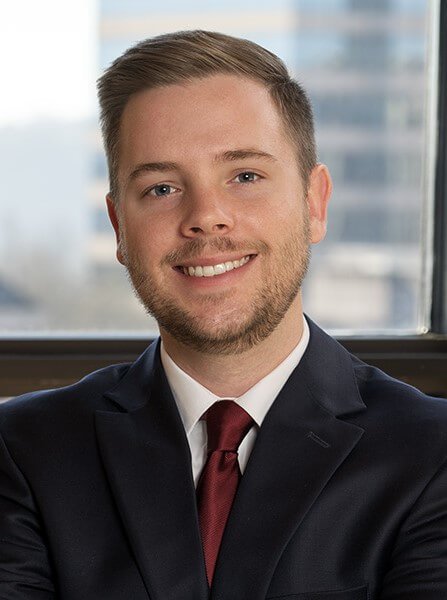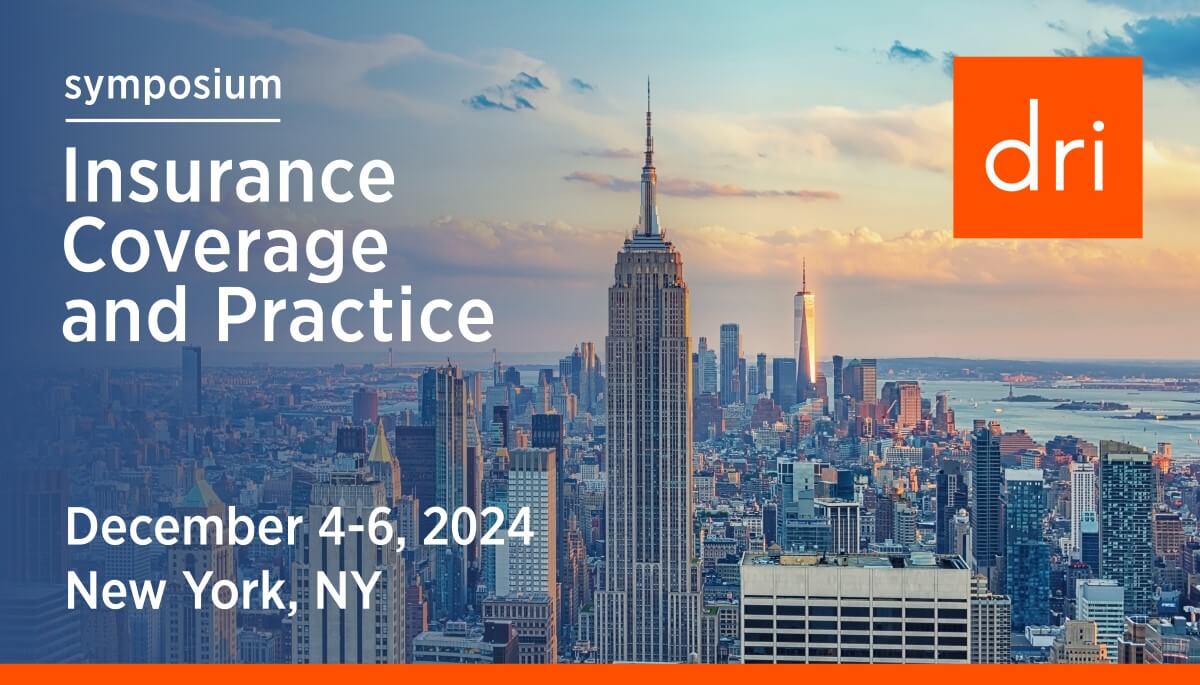Young Lawyers: Raising the Bar
Chair's Corner
By Tom Wyatt
On behalf of the Young Lawyers Committee, I hope all of you had a great summer and that you are enjoying the start of my favorite season of the year–fall.
The Young Lawyers Seminar in Nashville this June was an outstanding success. The seminar is, hands-down, one of my favorite DRI events each year because it gives me so many opportunities to connect with the friends, colleagues, and networking contacts that I have made throughout my years in DRI. Even better—the seminar is a great chance to get caught up on the latest trends in legal practice. This year was no different. We focused on practical skills with separate tracks for motion practice and depositions, strategies for business development, tips for trial whether you are first or third chair, and the latest trends in alternative dispute resolution and mediation. We also repeated one of our favorite seminar activities, the Fast Pitch Program, that pairs one of young lawyers with a corporate counsel to get feedback on their “pitches” for their firms and for practice. I extend my heartfelt gratitude to our Seminar Programming and Networking & Activities committees for all the hard work they did to put on a great and educational program.
I also want to extend a sincere thank you to all attendees at this year’s seminar, whether first-time or experienced, who participated in the Ambassador Program. At each seminar, our Membership committee matches someone who has never attended a DRI Seminar before with a member of the Young Lawyers Steering Committee or someone who has attended Young Lawyer Seminars previously. The program is a great way to get new DRI members connected and to make them feel welcome, but, of course, it would not be successful if we did not have all the willing volunteers that make the program possible. We had great feedback from our first-time attendees this year, and that goes a long way to fostering the growth and development that DRI membership brings.
I encourage all of you to make concrete plans to attend the DRI Annual Meeting that will also be held from October 16-18, 2024, in Seattle, Washington. You will not want to miss it. Mark your calendars, too, for next year’s Young Lawyers Seminar from June 11-13, 2025, in New Orleans, Louisiana. As always, please reach out to me if you need more help getting connected to Young Lawyers or a DRI committee in your practice area, or if you have someone in mind that you think would benefit from joining DRI.
 Tom Wyatt is a member of Quattlebaum, Grooms & Tull PLLC in Little Rock, Arkansas. Tom’s practice provides comprehensive and cost-effective service to a diverse client portfolio—from individuals to Fortune 500 companies—in litigation matters involving commercial and residential property development, land-use disputes, municipal interface and interference, complex commercial litigation, and products-liability defense. Tom currently serves as the Vice Chair of DRI Young Lawyers and as President of the Arkansas Association of Defense Counsel, DRI’s partner state defense organization in Arkansas.
Tom Wyatt is a member of Quattlebaum, Grooms & Tull PLLC in Little Rock, Arkansas. Tom’s practice provides comprehensive and cost-effective service to a diverse client portfolio—from individuals to Fortune 500 companies—in litigation matters involving commercial and residential property development, land-use disputes, municipal interface and interference, complex commercial litigation, and products-liability defense. Tom currently serves as the Vice Chair of DRI Young Lawyers and as President of the Arkansas Association of Defense Counsel, DRI’s partner state defense organization in Arkansas.
See You in Seattle at DRI’s Annual Meeting
By Steven A. Scoggan
DRI’s Annual Meeting in Seattle is coming up from October 16-18. Discounted registration is still available: DRI members pay only $1,595 ($500 off the standard price). Register now to take advantage of this substantial discount.
October is a great time to visit Seattle. Pike Place Market is a historic area filled with shops and vendors (and the [alleged] first Starbucks location). The Seattle Center has several exciting attractions—the Space Needle, the monorail, the International Fountain, and the Chihuly Garden and Glass. Enjoy views of the beautiful landscape surrounding Seattle by visiting the Sky View Observatory. Take a ferry ride to Bainbridge Island and enjoy a relaxing afternoon on a quaint island and fantastic views of the Seattle skyline from Puget Sound.
We have some fantastic Young Lawyers (YL) programming and networking opportunities at Annual. On Wednesday, two members of our committee will present on E-Discovery Tips, Tricks, and Tactics for the Young (or Young at Heart) Lawyer. This talk will touch on the full spectrum of e-discovery, including hold notices, document collection, e-discovery protocols, selecting search terms, reviewing and producing documents, and more. We’ll also have networking opportunities (with food!) for YLs on Wednesday evening. Stay tuned for more info.
Annual will also feature outstanding main-stage speakers. Bill Bradley, a former US Senator, will talk about the state of our country and share tips on how to meaningfully connect with each other during these increasingly divisive times. Noted travel expert Rick Steves will discuss how travel helps us broaden our perspectives and better understand one another. We’ll also have several other meeting-wide CLEs on topics such as lawyer wellbeing, AI, and other areas applicable to your litigation practice.
Finally, Annual always features a fantastic premier networking event. This year, the event will be held at Seattle’s Museum of Pop Culture. The museum touches on countless areas of pop culture, including music (with exhibits on Jimi Hendrix and Nirvana), science fiction, fantasy, horror films, a new exhibition on noted pop artist Keith Haring, and a massive collection of historical objects and artifacts from numerous musical genres.
Annual is going to be a blast! I hope to see you there next month.
 Steven A. Scoggan partners with clients facing significant changes and challenges in their professional and business relationships. He frequently advises clients about key employee departures and guides them through lawsuits involving employee raiding, unfair trade practices, trade secrets, and non-competition, non-solicitation, and non-disclosure agreements. Steven also advocates on behalf of business owners and officials in disputes about the management, control, and ownership of business enterprises.
Steven A. Scoggan partners with clients facing significant changes and challenges in their professional and business relationships. He frequently advises clients about key employee departures and guides them through lawsuits involving employee raiding, unfair trade practices, trade secrets, and non-competition, non-solicitation, and non-disclosure agreements. Steven also advocates on behalf of business owners and officials in disputes about the management, control, and ownership of business enterprises.
Football Is Back: Lessons for Lawyers from the Gridiron
By Ryan T. Shannon
As I’ve grown older, fall has firmly become my favorite season. Gone are the days of summer break and winter break. The residual good feelings of the reprieves these seasons once offered have faded. As someone who lives in a place that experiences all four seasons, I find myself quickly growing tired of the heat in the summer and the cold in the winter. Of course, the spring has a lot to offer, depending on how quickly the summer heat sets in. But even the best of springs cannot compete with fall. There is something magical about the coolness and crispness of the air in the fall. Maybe more than anything, though, fall sits comfortably at the top of the seasons power rankings for me because of football season.
Football season is relatively fleeting. Compared to other sports seasons, such as baseball and basketball spanning more than half a year, football season is really only in full swing for three or four months. Given the relatively few football weekends the calendar has to offer, I must admit I will be thinking about the practice of law as little as possible during this time. However, as football season gets into full swing, I have thought about a few lessons football offers on the practice of law.
1. Communication is key. I would argue that communication is more important in football than just about any other sport. On any given play, each player on the offense and defense has a particular job. What that job is depends on the play the coach sends in. If the play is not communicated to all 11 members of the team on the field, the result will be ugly. On the other hand, when each player knows their job and how that job fits into the big picture, the result can be beautiful.
So too in the practice of law. Of course, we all have an ethical and professional obligation to communicate with the client effectively. But communication is incredibly important within a law firm. When each member of the team who is on a particular case (lead attorney, associate attorney, paralegal, legal assistant) are on the same page, everyone can do their job most effectively. When you’re passing down a task, don’t just assign; explain, as well. Knowing the why and not just the what will often lead to a task being performed more effectively. Additionally, when a member of the team sees the big picture, they may be able to anticipate the needs of the case and be proactive, not just reactive. When we communicate effectively, the whole team can be at their best.
2. Use touch. It is widely accepted that Patrick Mahomes is the best quarterback in the NFL. One of the reasons Mahomes is so effective as a quarterback is his ability to know whether to make a strong throw or to throw the ball with touch in any given situation, and then execute the proper throw.
As attorneys, we must do the same thing. While we must always advocate for our client, that does not mean every communication with an opposing attorney should be fiery or mean. Certainly, we must be firm in our position, but this rarely requires brute force. Like an effective quarterback, we must throw a “catchable” ball. Be accurate. Be confident. But don’t forget to use some touch.
3. Master the rules. Bill Belichick is one of the most successful coaches in NFL history. While he benefited from having one of the greatest quarterbacks of all time in Tom Brady, Belichick earned much of his success by gaining a superior knowledge of the rules of football. One example of Belichick’s mastery occurred in a 2019 game against the New York Jets. The New England Patriots had a lead in the fourth quarter, so they intentionally committed multiple penalties to run down the clock. (As a Tennessee Titans fan, I thoroughly enjoyed head coach Mike Vrabel using this same tactic against Belichick and the Patriots in a playoff game later that season).
Likewise, lawyers can gain a leg up by mastering the rules of civil procedure. Cases can turn on the proper use of the rules of civil procedure. Further, studying the rules and staying abreast of changes to the rules is a relatively easy way for young attorneys to prove their value to more senior attorneys. Master the rules and apply them in your cases, and partners will notice. As a result, you will earn trust, respect, and work.
Now, let’s collectively breathe in the crisp fall air and enjoy the games.
 Ryan T. Shannon is an associate at Lewis Thomason’s Knoxville office. He focuses his practice in the areas of employment law, education law, insurance defense, and general civil litigation. He joined the firm as an associate attorney in 2021. As a student at the University of Tennessee College of Law, Mr. Shannon served as president and secretary of Vols for Veterans, as well as serving on the Career Services Committee.
Ryan T. Shannon is an associate at Lewis Thomason’s Knoxville office. He focuses his practice in the areas of employment law, education law, insurance defense, and general civil litigation. He joined the firm as an associate attorney in 2021. As a student at the University of Tennessee College of Law, Mr. Shannon served as president and secretary of Vols for Veterans, as well as serving on the Career Services Committee.
Interested in joining the Young Lawyers Committee? Click here for more information.
Print this section
Print the newsletter
Cybersecurity and Data Privacy: Data and Security Dispatch
The Catch-22 of Cybersecurity in the Age of AI
By Richik Sarkar
While artificial intelligence (AI) has the potential to revolutionize how businesses interact with customers, process sales, manage inventory, and more, it also brings with it new and unique cybersecurity risks. However, these risks can be mitigated with the right strategies. Companies must understand how AI works, consider how AI is deployed throughout their business structure, and take proactive steps to harness the potential benefits of AI in cybersecurity while minimizing security risks.
AI is generally any technology that utilizes an algorithm to process data, form new inferences, and make predictions beyond the original data set given to it by humans. The use of AI to make hiring decisions, offer 24/7 customer relations chatbots, ensure regulatory compliance, vet supply chains, and manage data is widespread.[1] The AI arms race is underway as innovators across different sectors look for the next significant advantage over their competitors.
However, the market demand to integrate AI also introduces new public-facing service endpoints, creating more cyberattack opportunities. Faster data processing means a higher rate of errors. Worse, fraudsters can use AI to find weaknesses, penetrate security, and access and extract data in less time. AI-powered cyberattacks are more accessible to execute and more precise because AI can spot patterns in a business’s security and extract data faster than humans.[2] To name just a few examples:
- AI accelerates brute force password cracking, bypasses CAPTCHA verification, and can adjust tactics in real time.[3]
- Third-party LLM plugins like ChatGPT can launch injection attacks, contain potentially dangerous natural language ambiguities, and often impose weak security policies, leading to improper user data harvesting, redirection of the authentication flow, misinformation, and more.[4]
- Through deep fakes and other AI that replicate a person’s face, likeness, body, speech, or writing patterns, fraudsters can organize highly targeted, compelling spear phishing attacks: impersonating a trusted source to penetrate a company’s cybersecurity defenses and promulgate a mass hacking campaign.[5] AI-powered spear phishing attacks often lack many telltale grammatical mistakes, brevity, and other apparent signs that employees use to spot and report phishing emails.[6] Existing deepfake detectors exhibit high error rates, as well as gender and racial bias.[7]
In sum, the rapid speed of AI development risks missing flaws that make businesses vulnerable. Unprepared companies will soon face a plethora of legal risks:
- Cyberattacks that compromise personally identifiable information may trigger expensive disclosure requirements under federal or state law depending on who is affected, the number of affected individuals, and what information is compromised. Data breaches are likely to become more expensive because an AI can access more of a victim’s database in less time.
- The Federal Trade Commission (FTC), the federal agency responsible for enforcing similar laws, recently signaled its intent to reduce consumer data breach notice fatigue and increase follow-through on post-breach remedies such as credit monitoring.[8]
- Failure to comply with standards for cybersecurity systems may lead regulators to impose fines.
- The failure to take appropriate precautions against cyberattacks may constitute a breach of the fiduciary duties of supervision, care, and loyalty.
- Misuses of AI may violate social norms, alienate customers and other stakeholders, and lead to reputational damage. For example, Amazon’s facial identification feature has been accused of gender bias,[9] Google has faced backlash for helping the federal government analyze drone footage through AI.[10]
These vulnerabilities are all the more dangerous to systems that lack AI-based countermeasures. Businesses should integrate AI into their cybersecurity systems to help prevent, detect, and respond to data breaches. AI’s ability to quickly process data allows for comprehensive vulnerability scans, early detection of fraud by analyzing patterns in emails as they enter a user’s inbox, reviews of historical data to locate the root cause of an incident, streamlining communications to appropriate team members and categorizing and triaging incidents based on their potential harm to the organization.[11] Additionally, companies should:
- Maintain communication with their IT/cybersecurity team and conduct at least annual reviews of cybersecurity policies and weaknesses, which include reviewing what data is being used to train any AI the company utilizes.
- Understand the technology underlying AI, its potential for failure, regulators’ expectations, what public statements about AI use are credible, and how AI fits into more extensive governance and corporate culture problems.
- Regular training for executives and employees on the company’s use of AI, spear phishing, and other cybersecurity risks in the age of AI.
- Review cyber insurance policies for gaps in coverage that AI may create. The rise in cyberattacks has caused cyber insurance premium hikes, and most companies remain insufficiently covered.[12] Even “[f]or businesses with cyber insurance coverage, AI risks may not fit neatly into the language of those policies, and insurers may argue that exclusions or gaps in policy wordings apply.”[13] Thus, companies should also consider retaining AI-specific insurance policies.
- Retain a data incident response vendor and legal counsel with expertise in AI before an incident occurs.
[1] See Alfred R. Cowger, Jr., Corporate Fiduciary Duty in the Age of Algorithms, 14 J. of Law, Tech. & The Internet 138, 158-59 (2023); Deciphering AI Risk Insurance: Beyond Cyber Coverage, ProgramBusiness (Aug. 31, 2023).
[2] Rachel Curry, Companies want to spend more on AI to defeat hackers, but there’s a catch, CNBC (Oct. 3, 2023) (https://www.cnbc.com/2023/10/03/companies-spending-more-on-ai-to-defeat-hackers-but-theres-a-catch.html).
[3] Steve Alder, Editorial: Why AI Will Increase Healthcare Data Breaches, The HIPAA Journal (Oct. 12, 2023) (https://www.hipaajournal.com/editorial-why-ai-will-increase-healthcare-data-breaches/#:~:text=Due%20to%20a%20lack%20of,increase%20in%20healthcare%20data%20breaches).
[4] Umar Iqbal et al., LLM Platform Security: Applying a Systematic Evaluation Framework to OpenAI’s ChatGPT Plugins, (Fed. Trade Comm’n PrivacyCon, 2024) (https://arxiv.org/pdf/2309.10254.pdf).
[5] Josianne El Antoury, How Insurance Policies Can Cover Generative AI Risks, Law360 (Oct. 4, 2023).
[6] Alder, Editorial: Why AI Will Increase Healthcare Data Breaches.
[7] Mehrdad Saberi et al., Robustness of AI-Image Detectors: Fundamental Limits and Practical Attack (ICLR, 2024) (https://arxiv.org/pdf/2310.00076.pdf); Yan Ju et al., Improving Fairness in Deepfake Detection (2024) (https://openaccess.thecvf.com/content/WACV2024/papers/Ju_Improving_Fairness_in_Deepfake_Detection_WACV_2024_paper.pdf).
[8] Commissioner Lina Khan, Federal Trade Commission, Remarks at the Federal Trade Commission PrivacyCon, March 6, 2024.
[9] James Vincent, Gender and racial bias found in Amazon’s facial recognition technology (again), The Verge (Jan. 25, 2019) (https://www.theverge.com/2019/1/25/18197137/amazon-rekognition-facial-recognition-bias-race-gender).
[10] Matthias Holweg, et al., The Reputational Risks of AI, CAL. MANAGEMENT REV. (Jan. 24, 2022).
[11] Matthew White & Justin Daniels, Using AI in Cyber Incident Response Demands a Total Safety Check, Bloomberg Law (Nov. 14, 2023) (https://news.bloomberglaw.com/us-law-week/using-ai-in-cyber-incident-response-demands-a-total-safety-check).
[12] Nirmal Kumar J, How AI will boost cyber insurance industry growth, Tata Consulting Servs. (https://www.tcs.com/what-we-do/industries/insurance/white-paper/ai-overcoming-cyber-insurance-industry-challenges).
[13] El Antoury, How Insurance Policies Can Cover Generative AI Risks.
 Richik Sarkar is a partner in the Cleveland, Ohio office of Dinsmore & Shohl LLP – a longtime supporting of DRI. Richik is a legal strategist who transforms complex business challenges into winning solutions. He is nationally recognized as a top lawyer, and he empowers companies and boards by providing clear, actionable insights on matters such as litigation, regulatory compliance, and ESG issues, including data privacy, business strategy, and governance.
Richik Sarkar is a partner in the Cleveland, Ohio office of Dinsmore & Shohl LLP – a longtime supporting of DRI. Richik is a legal strategist who transforms complex business challenges into winning solutions. He is nationally recognized as a top lawyer, and he empowers companies and boards by providing clear, actionable insights on matters such as litigation, regulatory compliance, and ESG issues, including data privacy, business strategy, and governance.
Interested in joining the Cybersecurity and Data Privacy Committee? Click here for more information.
Insurance Law: Covered Events
Leadership Note | Transportation SLG
By William A. Bulfer
Edited by Allyson L. Moore
It has been an exciting year for the Transportation Law SLG, with a presentation on the Intersection of Insurance and Commercial Transportation at the 2024 Insurance Coverage and Claims Institute in Chicago. A number of the SLG’s members also took time to connect at the 2024 Bad Faith Seminar in Nashville. As we look toward the end of the year, our group will be looking to connect once again at the Insurance Coverage and Practice Symposium in New York City. Please reach out to me at wbulfer@teaguecampbell.com if you’d like to join! Heading into 2025, the group continues to monitor the ever-evolving landscape of Transportation Law in the context of insurance coverage. Whether it be the increasing use of artificial intelligence, the expansion of bad faith into new jurisdictions, or evolving questions on policy limits and coverage strategy, the Transportation SLG continues to be a great resource for the insurance industry and its ongoing partnership with the various transportation industries.
 William A. Bulfer is a partner in the Asheville office of Teague Campbell Dennis & Gorham.
William A. Bulfer is a partner in the Asheville office of Teague Campbell Dennis & Gorham.
Leadership Note | Special Investigation Unit/Fraud SLG
By Ed Carlton
Edited by Allyson L. Moore
Well, Fall has finally arrived! College football is underway and some of your teams may be doing well (not my Tar Heels). And the Insurance Coverage and Practice Symposium in December is right around the corner (everyone sign up)! But there is still time this year to become more active in the Insurance Law Committee. So, I would like to take the opportunity to provide some insight on the DRI Insurance Law Committee’s SIU/Fraud Substantive Law Group. This group seeks to provide opportunities for DRI insurance professionals and practicing attorneys to address recent trends and current information on emerging areas in insurance fraud and initiatives in the insurance industry to counter such activities. Twice a year, our subcommittee gets the opportunity to author SIU/Fraud articles for The Brief Case. Over the years, those have been extraordinarily informative, and some have led to opportunities for our members to speak at DRI Seminars. If you haven’t read it yet, you should read the article by Andrew Willis, Suspected Fraud After the Insured has Assigned Benefits: Practical Considerations, in the April Brief Case. And I want to again welcome Andrew to his new role, as Vice Chair of this great group! We have begun to discuss the needs and opportunities within our SLG as well as the ILC. Hopefully, with Andrew’s energy, we can get younger, more vibrant SLG members like him in management positions, and can provide even greater service. So, if your practice involves or you have an interest in SIU/Fraud, there is an opportunity through this subcommittee to get involved and to provide a valuable resource to the insurance industry. Join us by contacting Ed Carlton at ecarlton@qslwm.com or Andrew Willis at andrew.willis@mgclaw.com. Go Heels!
 Ed Carlton of Quilling, Selander, Lownds, Winslett & Moser represents business clients in complex civil litigation. He provides consultation and representation in numerous areas of insurance coverage and defends insurers and third-party administrators with respect to coverage disputes and claims of insurance bad faith, deceptive trade practices and insurance code violations.
Ed Carlton of Quilling, Selander, Lownds, Winslett & Moser represents business clients in complex civil litigation. He provides consultation and representation in numerous areas of insurance coverage and defends insurers and third-party administrators with respect to coverage disputes and claims of insurance bad faith, deceptive trade practices and insurance code violations.
Interested in joining the Insurance Law Committee? Click here for more information.


